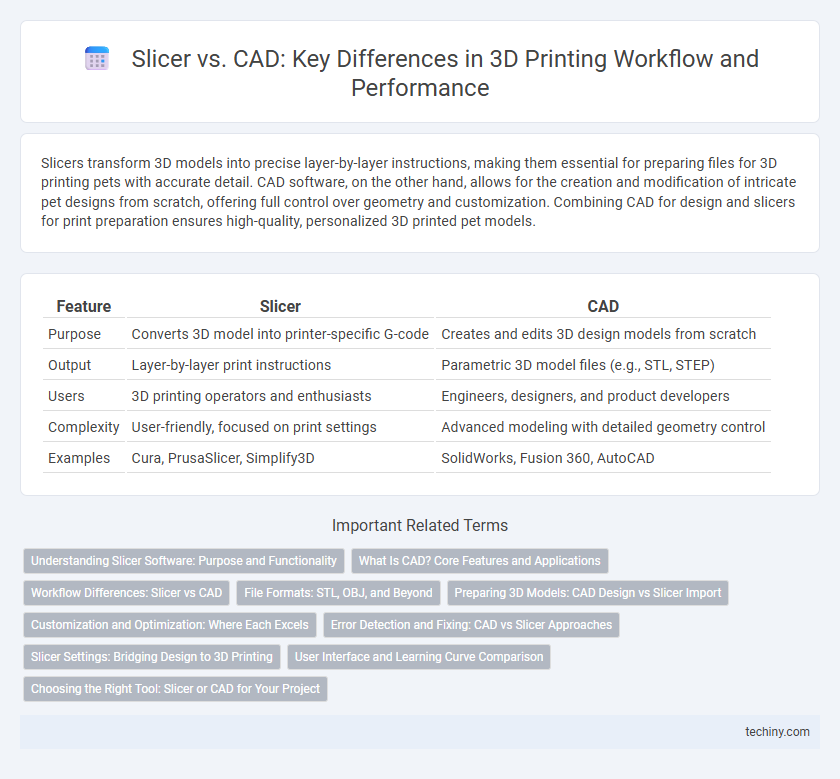Slicers transform 3D models into precise layer-by-layer instructions, making them essential for preparing files for 3D printing pets with accurate detail. CAD software, on the other hand, allows for the creation and modification of intricate pet designs from scratch, offering full control over geometry and customization. Combining CAD for design and slicers for print preparation ensures high-quality, personalized 3D printed pet models.
Table of Comparison
| Feature | Slicer | CAD |
|---|---|---|
| Purpose | Converts 3D model into printer-specific G-code | Creates and edits 3D design models from scratch |
| Output | Layer-by-layer print instructions | Parametric 3D model files (e.g., STL, STEP) |
| Users | 3D printing operators and enthusiasts | Engineers, designers, and product developers |
| Complexity | User-friendly, focused on print settings | Advanced modeling with detailed geometry control |
| Examples | Cura, PrusaSlicer, Simplify3D | SolidWorks, Fusion 360, AutoCAD |
Understanding Slicer Software: Purpose and Functionality
Slicer software transforms 3D CAD models into detailed, layer-by-layer instructions that guide 3D printers in fabricating objects with precision. It generates G-code, specifying print paths, temperatures, and speeds essential for successful prints. Unlike CAD programs that design models, slicers optimize printing parameters to enhance quality and efficiency in additive manufacturing.
What Is CAD? Core Features and Applications
CAD (Computer-Aided Design) software enables precise 3D modeling and drafting, essential for creating complex designs with exact dimensions. Core features include parametric modeling, 2D and 3D visualization, and simulation tools that help engineers and designers validate and optimize their creations before printing. CAD is widely applied in industries such as automotive, aerospace, architecture, and product design, forming the foundational step in the 3D printing workflow.
Workflow Differences: Slicer vs CAD
Slicer software transforms 3D models into printable G-code by slicing the design into layers and optimizing print parameters, while CAD software focuses on creating and refining the 3D geometry itself. The workflow in CAD involves detailed design, modification, and engineering aspects, whereas slicers prioritize converting the CAD model for precise printer instructions and material control. This fundamental difference highlights CAD as the source of digital models and slicers as the bridge to physical fabrication.
File Formats: STL, OBJ, and Beyond
STL and OBJ are the most commonly used file formats in 3D printing, with STL primarily supporting simple geometry and OBJ offering color and texture information for more detailed models. CAD software typically exports designs in proprietary or versatile formats like STEP or IGES before conversion to STL or OBJ for slicing. Slicer programs optimize these files by generating precise G-code instructions that 3D printers use to fabricate objects layer by layer.
Preparing 3D Models: CAD Design vs Slicer Import
Preparing 3D models involves distinct workflows in CAD design and slicer import processes. CAD software enables precise, parametric modeling with detailed control over geometry and features, essential for creating accurate designs from scratch. In contrast, slicer software focuses on importing existing 3D models, optimizing them for printability by generating supports, adjusting layer height, and slicing the model into printable layers for the 3D printer.
Customization and Optimization: Where Each Excels
Slicer software excels in customization and optimization by allowing users to adjust print settings such as layer height, infill density, and support structures to enhance print quality and efficiency. CAD programs offer superior control over design customization, enabling precise creation and modification of 3D models before printing. While CAD focuses on detailed model design, slicers optimize the printing process, making both essential for different stages of 3D printing.
Error Detection and Fixing: CAD vs Slicer Approaches
CAD software offers advanced error detection by allowing users to identify and correct design flaws such as intersecting surfaces, non-manifold edges, and missing geometry during the modeling phase. Slicer software focuses on preparing the design for printing by detecting issues like layer inconsistencies, unsupported overhangs, and gaps in the mesh, often providing automatic repair tools for these printing-specific errors. Combining CAD's precise geometric error correction with the slicer's mesh repair capabilities enhances overall print quality and reduces failed prints.
Slicer Settings: Bridging Design to 3D Printing
Slicer settings serve as the critical link between CAD models and successful 3D prints by translating digital designs into precise, layer-by-layer instructions for the printer. Optimizing parameters such as layer height, infill density, print speed, and support structures directly affects the print's accuracy, strength, and surface finish. Advanced slicers also offer features like adaptive layering and custom support generation, enhancing the fidelity of complex geometries derived from CAD files.
User Interface and Learning Curve Comparison
Slicer software offers a streamlined user interface tailored for 3D printing preparation, featuring intuitive controls for layer settings, support generation, and print preview that reduces the learning curve for beginners. In contrast, CAD software provides a more complex interface designed for detailed 3D modeling and design, requiring advanced skills and longer training to master parametric features and precision controls. Users prioritizing quick print setup often prefer slicers, while those needing intricate design capabilities invest time learning CAD environments.
Choosing the Right Tool: Slicer or CAD for Your Project
Choosing the right tool for your 3D printing project depends on the stage of development and the desired outcome. CAD software excels in creating precise, editable 3D models from scratch, offering detailed control over geometry and design parameters. Slicer software, however, prepares the finalized 3D model for printing by generating optimized G-code, managing print settings such as layer height, infill density, and support structures crucial for achieving successful prints.
Slicer vs CAD Infographic

 techiny.com
techiny.com